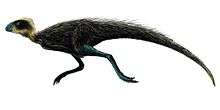Sarcosaurus
| Sarcosaurus Temporal range: Early Jurassic, 194 Ma | |
|---|---|
 | |
| Pelvis and parts of femur and dorsal vertebra | |
| Scientific classification | |
| Kingdom: | Animalia |
| Phylum: | Chordata |
| Class: | Reptilia |
| Clade: | Dinosauria |
| Order: | Saurischia |
| Suborder: | Theropoda |
| Superfamily: | †Coelophysoidea |
| Genus: | †Sarcosaurus Andrews, 1921 |
| Species | |
| |
| Synonyms | |
|
"Liassaurus" huenei? Magnosaurus woodwardi? Megalosaurus lydekkeri? | |
Sarcosaurus (meaning "flesh lizard") is a genus of theropod dinosaur, either a coelophysoid or a basal ceratosaur, roughly 3.5 metres (11 ft) long. It lived during the Sinemurian stage of the Early Jurassic, about 194 million years ago. If the specimen called "Liassaurus" is confirmed as a synonym, Sarcosaurus would have an adult length over 6 metres (20 ft).
Fossils of Sarcosaurus were found in the Lower Lias of England. The type species, Sarcosaurus woodi, was first described by Charles William Andrews in 1921 shortly after a partial skeleton had been found by S.L. Wood near Barrow-on-Soar. The generic name is derived from Greek sarx, "flesh". The specific name honours Wood. The holotype, BMNH 4840/1, consists of a pelvis, a vertebra and the upper part of a femur. The preserved length of the femur is 31.5 centimetres (12.4 in).[1]
A second species, Sarcosaurus andrewsi, was named by Friedrich von Huene in 1932,[2] based on a 445 millimetres (17.5 in) tibia, BMNH R3542, described by Arthur Smith Woodward in 1908 and found near Wilmcote.[3] Confusingly von Huene in the same publication named the very same fossil Magnosaurus woodwardi. Later he made a choice for S. andrewsi to be the valid name.[4] In 1974 S. andrewsi was reclassified as Megalosaurus andrewsi by Michael Waldman, on the probably erroneous assumption it was a megalosaurid.[5] A later study concluded the two species to be indistinguishable except for size,[6] but other authors consider any identity to be unprovable as there are no comparable remains and conclude both species to lack autapomorphies and therefore to be nomina dubia.[7]
Von Huene in 1932 referred a partial skeleton from the collection of the Warwick Museum to S. woodi but the identity is unproven; in 1995 it was given the generic name "Liassaurus"[8] but this has remained a nomen nudum.
Andrews originally assigned Sarcosaurus to the Megalosauridae. The first to suggest a more basal position was Samuel Paul Welles who placed it in the Coelophysidae.[9] Later analyses resulted in either a position in the Ceratosauria,[10] or in the Coelophysoidea.[11]
See also
References
- ↑ Andrews, C.W., 1921, "On some remains of a theropodous dinosaur from the Lower Lias of Barrow-on-Soar", Annals and Magazine of Natural History, series 9 8: 570-576
- ↑ von Huene, F., 1932, Die fossile Reptil-Ordnung Saurischia, ihre Entwicklung und Geschichte, Monographien zur Geologie und Palaeontologie 1(4) pp. 361
- ↑ Woodward, A.S. 1908. "Note on a megalosaurian tibia from the Lower Lias of Wilmcote, Warwickshire". Annals and Magazine of Natural History. 8(1): 257-259
- ↑ Huene, F. von, 1956, Paläontologie und Phylogenie der niederen Tetrapoden. Gustav Fischer Verlag, Jena. 716 pp
- ↑ Waldman, M. 1974. "Megalosaurids from the Bajocian (Middle Jurassic) of Dorset". Paleontology 17(2): 325-339
- ↑ Carrano and Sampson (2004). "A review of coelophysoids (Dinosauria: Theropoda) from the Early Jurassic of Europe, with comments on the late history of the Coelophysoidea." N. Jb. Geol. Palaont. Mh., 2004(9): 537-558.
- ↑ D. Naish and D. M. Martill. 2007. "Dinosaurs of Great Britain and the role of the Geological Society of London in their discovery: basal Dinosauria and Saurischia". Journal of the Geological Society, London 164: 493-510
- ↑ Pickering, S. 1995. Jurassic Park: Unauthorized Jewish Fractals in Philopatry. A Fractal Scaling in Dinosaurology Project, 2nd revised printing. Capitola, California. 478 pp
- ↑ S.P. Welles. 1984. "Dilophosaurus wetherilli (Dinosauria, Theropoda): osteology and comparisons". Palaeontographica Abteilung A 185: 85-180
- ↑ J A. Gauthier. 1986. "Saurischian monophyly and the origin of birds". In: The Origin of Birds and the Evolution of Flight, K. Padian (ed.), Memoirs of the California Academy of Sciences 8: 1-55
- ↑ M.T. Carrano, J.R. Hutchinson, and S.D. Sampson. 2005. "New information on Segisaurus halli, a small theropod dinosaur from the Early Jurassic of Arizona". Journal of Vertebrate Paleontology 25 (4): 835-849



